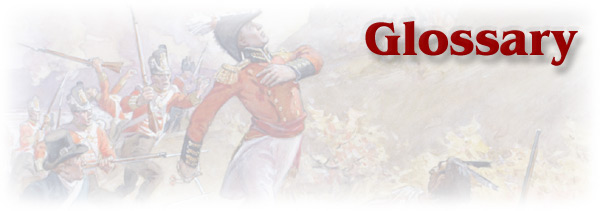A
B
C D
E F G H
I J K L
M N O P
Q R S
T U V W X Y Z
|
|
Aide-de-camp
Senior officers were assisted in the daily
management of their command by a more junior officer,
the aide-de-camp.
[Return to top of page] |
|
Ancaster Bloody Assize, 1814
See Treason Trials.
[Return to top of page] |
|
Barracks
Building used to house troops, very often in Upper Canada
they were blockhouses in the forts.
[ Return to top
of page ] |
|
Bastion
A corner of a fort generally armed with cannon, designed
so that it could fire along flanking walls against attackers.
[ Return to top
of page ] |
|
Bateau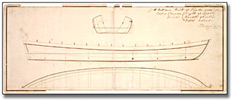
A shallow draft boat used to move supplies on the rivers
and lakes of the Canadas. |
| [ Return to top
of page ] |
|
Battalion
A body of soldiers consisting of several companies, generally
two battalions made up a regiment.
[ Return to top
of page ] |
|
Battery
Two or more guns, sometimes mounted in a fort’s
bastion.
[ Return to top
of page ] |
|
Blockade
The use of naval power to prevent an enemy nation from
shipping goods from its ports. Generally it involves stationing
war vessels off the coast to prevent the departure of
commercial or war ships.
[ Return to top
of page ] |
|
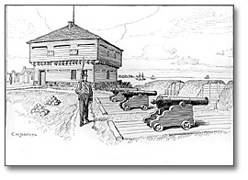
Blockhouse
A fortified building, sometimes part of a larger fort,
used as a barracks for the troops and as a strong point
during an attack. |
| [ Return to top
of page ] |
|
British North America
That part of North America which did not separate from the British Empire as part of the United States in 1783. The colonies of Upper and Lower Canada, Nova Scotia, New Brunswick, Prince Edward Island and Newfoundland were the individual components of British North America.
[ Return to top
of page ] |
|
Campaign
A military operation with some more or less defined objective
that might involve a combination of movement and one or
more battles. The most sustained campaign of the War of
1812 followed the American invasion of Niagara in 1814.
[ Return to top
of page ] |
|
Canister
Small iron balls fired from a cannon with the effect
of a shotgun, scattering shot in all directions.
[ Return to top
of page ] |
|
Citadel
Large hill top fortifications, the best examples in Canada
are at Quebec City and Halifax.
[ Return to top
of page ]
|
|
Commissariat
The supply wing of an army.
[ Return to top
of page ] |
|
Commission
The document recognizing an officers rank in the military
hierarchy. Ensign-Lieutenant-Captain-Major-Colonel-General,
with many gradations within each rank.
[ Return to top
of page ]
|
|
Company
A body of soldiers numbering 60-100, generally commanded
by a captain.
[ Return to top
of page ] |
|
Dragoons
A type of cavalry that could also fight as infantry.
[ Return to top
of page ] |
|
Flank
The right or left side of a military formation, generally
considered the most vulnerable point at which to launch
and attack.
[ Return to top
of page ]
|
|
French Revolution
The rebellion, 1789, that eventually overthrew the French
Monarchy for a republic, which was overthrown by Napoleon
Bonaparte.
[ Return to top
of page ] |
|
Garrison
Troops defending a fortification or a town.
[ Return to top
of page ] |
|
Grape Shot
Like canister,
small iron balls fired from a cannon with the effect of
a shotgun, scattering shot in all directions.
[ Return to top
of page ] |
|
Guns 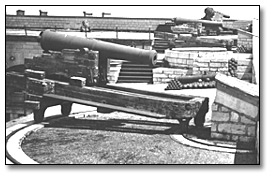
Smooth bore artillery firing solid shot or various forms
of canister. |
| [ Return to top
of page ] |
|
Habeas Corpus
Legal term, a justice of the peace could issue a writ
of habeas corpus requiring that the authorities either
release or charge an individual in custody with a specific
crime.
[ Return to top
of page ]
|
|
Incorporated Militia
Local troops to be trained and equipped like regular
forces and to serve for the duration of the War. See also
Sedentary Militia.
[ Return to top
of page ] |
|
King’s Shilling
A recruit to the British army would receive a shilling
on signing up.
[ Return to top
of page ] |
|
Loyalist
Those who supported the British government during the
American War of Independence, many of them moved to Upper
Canada in the 1780s and 1790s.
[ Return to top
of page ] |
|
Milan Decrees
These were orders issued by Napoleon Bonaparte
as Emperor of France closing European ports to trade with
Britain and neutral ships that had stopped at British
ports.
[ Return to top
of page ] |
|
Militia
The part-time civilian military force used in Great Britain,
Upper Canada and the United States. See also Incorporated
Militia and Sedentary Militia.
[ Return to top
of page ] |
|
Orders-in-Council
Order issued under the signature of
the King of Great Britain, or of a Governor in a British
colony, that set regulations on a particular issue. In the
case of the War of 1812, the Orders-in-Council restricted
trade
by neutrals with France.
[ Return to top
of page ] |
|
Ordnance
Artillery and related ammunition and equipment.
[ Return to top
of page ] |
|
Palisades
A line of vertical stakes embedded in the ground used
as part of a fortification.
[ Return to top
of page ]
|
|
Parole
A written agreement in which a soldier was released from
captivity by agreeing not to serve again either for a
specific period of time or until the war ended.
[ Return to top
of page ] |
|
Powder Magazine
A building, generally within a fort, designed store gunpowder.
[ Return to top
of page ] |
|
Prize Money
Troops received a share of the proceeds from the sale
of goods captured in military campaigns.
[ Return to top
of page ] |
|
Quartermaster
Military officer responsible for distribution of supplies
to the troops (from the Commissariat Department) and the
provision of quarters in the field.
[ Return to top
of page ] |
|
Rebellion of 1837
A rebellion against British rule in Upper Canada, the
rebels were quickly defeated. In 1838-1840 there were
several raids from the United States by supporters of
the rebellion, including an attack on Brock’s Monument.
[ Return to top
of page ] |
|
Rush-Bagot Treaty
A treaty between Great Britain and the United States
which limited the size of naval forces both sides could
maintain on the Great Lakes and Lake Champlain, signed
in 1818.
[ Return to top
of page ] |
|
Sedentary Militia
Under the Militia Act all able bodied males in Upper
Canada were obligated to serve in the militia. The Sedentary
Militia was the part of the eligible force that was only
called up in case of emergency and had limited training
and little equipment. See also Incorporated Militia.
[ Return to top
of page ] |
|
Squadron
A. A small naval force.
B. A small cavalry force. [ Return to top
of page ] |
|
Stores
Military supplies of all kinds.
[ Return to top
of page ] |
|
Strategy
The use of manoeuvre and movement to obtain
an advantage over an opposing army. [ Return to top
of page ] |
|
Tactics 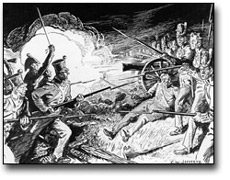
The use of weapons and men on the battlefield.
|
| [ Return to top
of page ] |
|
Theatre (of operations)
A geographic area defining where military operations
occurred. For example, The St. Lawrence, Niagara and Detroit
Rivers defined three of the major theatres of the 1812
conflict.
[ Return to top
of page ] |
|
Treason Trials
In the spring of 1814 the Government of Upper Canada conducted a series of trials of men accused of aiding the American forces the previous year during the enemy occupation of the Niagara and Western districts. The assize (court hearing) was held at the small community of Ancaster (part of Hamilton today). Fifteen were convicted of treason. The sentences of seven were eventually commuted to expulsion from the province. The remaining eight were hanged at Ancaster in July, 1814.
[ Return to top
of page ] |
|
Treaty of Ghent
The treaty between Great Britain and the United States
that brought the War of 1812 to an end. It was finalized
early in 1815.
[ Return to top
of page ]
|
|
